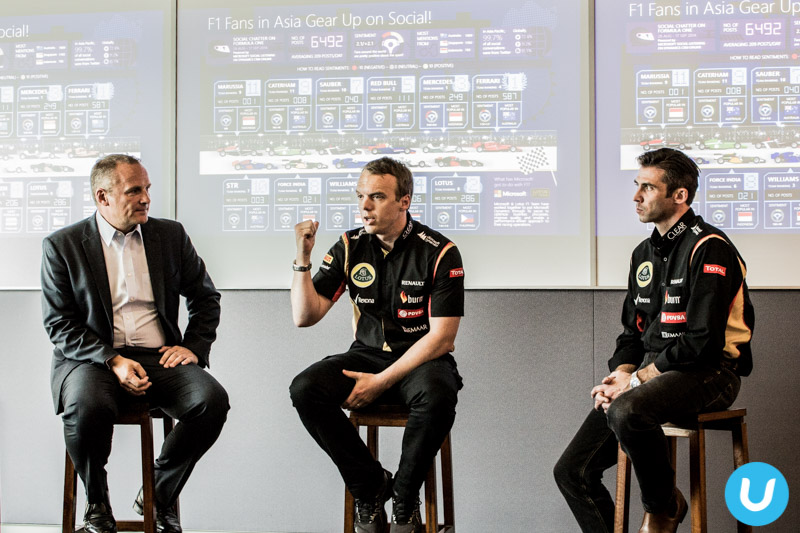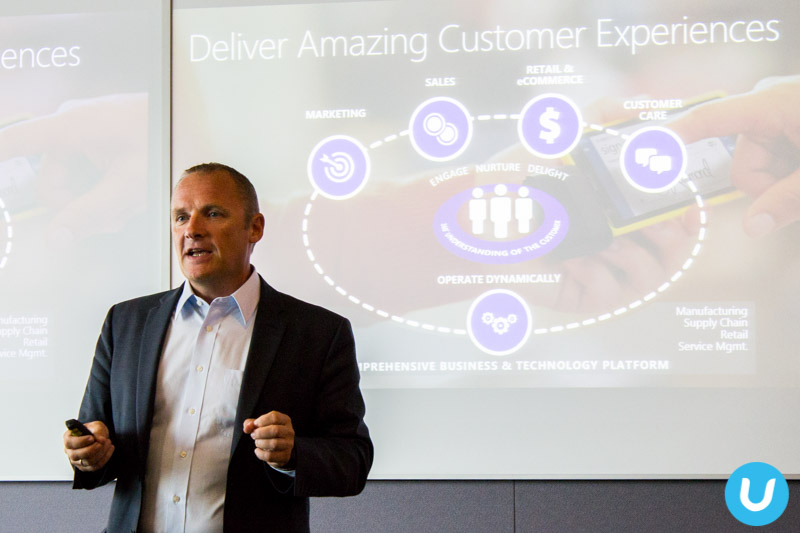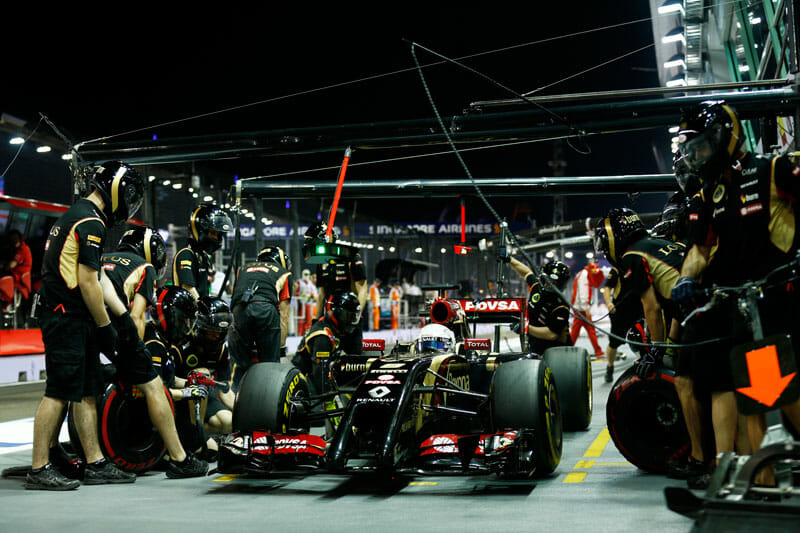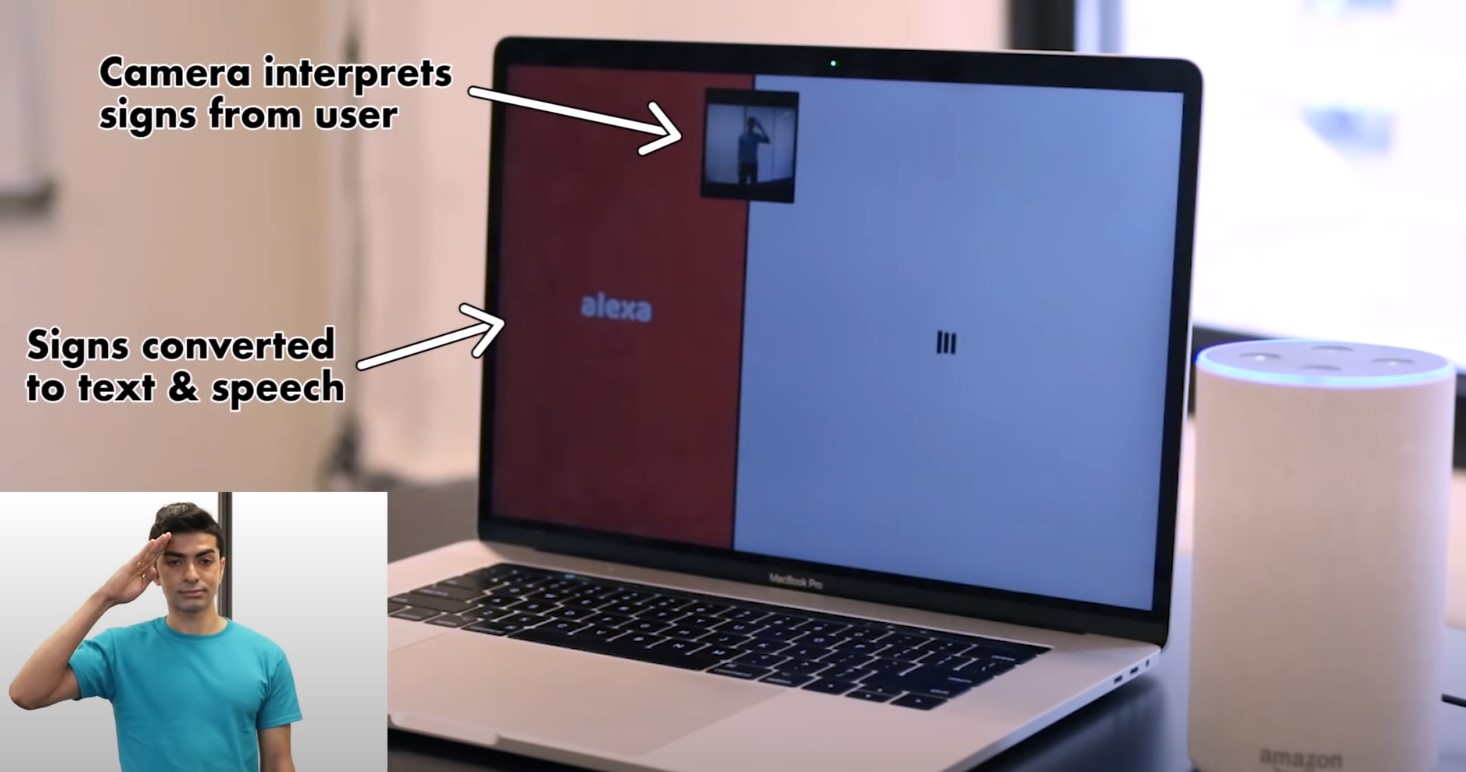One weekend ago, I was given the opportunity to spend some time with the Microsoft Dynamics team and the Lotus F1 Team in Singapore – for the Singapore F1 GP race weekend. It couldn’t have been a better mash-up of interests for me – technology and auto racing. Seemingly poles apart in terms of verticals, and yet, as the Microsoft-Lotus F1 Team partnership has shown, two that share a similar performance-driven approach in operations and processes.
Keynotes and presentations were delivered by Cesar Cernuda, President, Microsoft Asia Pacific; Adrian Johnston, VP Microsoft Dynamics, Asia; Christian Pederson, GM Microsoft Dynamics AX; Matthew Carter, CEO, Lotus F1 Team; and Michael Taylor, CIO, Lotus F1 Team. There was also a panel discussion involving Pederson, Johnston, Taylor, Carter and Shanmugababy Gandhimani, GM of eCommerce, MindChamps.
Lotus: deeply-rooted racing pedigree
Lotus has a rich history in racing and motorsports – the original 1954-1994 Team Lotus ran cars in many motorsports series including Formula One. Notable drivers include Jim Clark, Graham Hill, Aryston Senna, Nigel Mansell and Mika Hakkinen.
The modern day Lotus F1 Team competed for the first time in the 2012 Formula One season where it won a race and had several podium finishes through Kimi Raikkonen and Romain Grosjean. The team was positioned fourth in the Formula One Constructors’ World Championship.
In 2013, the team took fourth position again in the Constructors’ World Championship with Kimi Raikkonen, Heikki Kovalainen and Romain Grosjean as drivers.
For this year’s season, drivers are Romain Grosjean and Pastor Maldonado, running the 2014 E22 car – powered by a Renault Energy F1-2014 1.6 V6 turbo engine.
The start of a partnership
Auto racing is a sport where every millisecond counts. And while we, as spectators see the thrills and spills on the outside, there’s more that meets the eye. There’s no denying there’s an obsession for perfection, as racing rewards precision and therefore, the team is persistently pushed to the limits in terms of manpower, processes, cars and drivers.
The smallest detail and split second decision could be determinant of a podium finish.
The Lotus F1 Team comprises around 470 personnel, 35 of whom are IT-based.

Matthew Carter, new CEO of Lotus F1 Team said, “Tackling incredible odds and well-funded competition means pulling together as a team across an organisation that includes mechanics, aerodynamics, fabricators and more. This requires transparency and clarity of insight into every single decision that we make about the cars that we put on the starting grid at next weekend’s race. Our partnership with Microsoft enables us to harness all of the expertise and experience in the team. The more predictable we can be with process and the more effective we can be at improving the cars the more of a chance we will have to fight for a spot in the podium.”
Pre-2012, as explained by Michael Taylor CIO, Lotus F1 Team, the team was using over 10 different systems for its performance and manufacturing systems. In order to remain competitive and outperform other bigger teams, Lotus F1 Team needed a transformation from the ground up.
“Our partnership with Microsoft enables us to harness all of the expertise and experience in the team. The more predictable we can be with process and the more effective we can be at improving the cars the more of a chance we will have to fight for a spot in the podium.”
Much more than an ERP
The Lotus F1 Team extensively evaluated 13 ERP solutions which were assessed on eight different criteria – user experience, architecture, business process management, production, support, reporting, integration and total cost of ownership. The race team eventually settled on the Microsoft Dynamics AX solution to help the team optimise their business processes, improve quality and enable a performance-driven approach to their operations.
As Taylor puts it, Microsoft Dynamics is “much more than an ERP solution.”
The partnership which is both sponsorship and commercial kicked off in 2012 and is planned through to 2016.

The details that matter
The Lotus F1 Team produces five car chassis a year, with two cars running the season with an approximate budget of 135 million pounds. This is 1/3 of the budget of a bigger team like McLaren.
Even the smallest parts of the car go through constant enhancements – in design, aerodynamics and structural strengthening. Each season, thousands of designs are created based on over 65GB of logged data per race. There are no less than 150 sensors on each car that logs data in wind tunnel tests and computerised simulations.
Typically throughout the season, a car can change by as much as 70%.
Data and the delivery of relevant information to the right person efficiently is crucial in every tactical and business aspect of Formula One.
With Microsoft Dynamics in place, Lotus F1 Team’s performance and manufacturing systems are integrated into a single environment – fine tuning and driving every aspect of the business. From managing design, manufacturing and testing of the 15,000-plus parts on the car, to analysing real-time data on the race circuit.
In essence, the agility of Microsoft Dynamics has helped improve capacity planning, improve management of information, provide automation across the F1 car lifecycle and integrate systems to bring enhanced data accuracy and resource reporting.
This translates to more informed business decisions that help provide a competitive edge over better-funded teams, improve agility, balance cost vs performance and balance risk vs reward.
The transformation of the Lotus F1 Team with Microsoft Dynamics is three-prong:
- Phase 1: Improvements to financials, HR, purchasing and materials management (Nov 2012)
- Phase 2a: Bringing the Aerodynamics division online via Microsoft Dynamics Life Cycle Services (LCS), powered by Microsoft cloud. Aerodynamics, being the “beating heart of the team” is where it begins – from the first prototypes to the final product. Thousands of iterations and parts, handled expertly with Microsoft Dynamics AX. (October 2013)
- Phase 2b: Bringing the rest of manufacturing and production planning and scheduling online (2H 2014).
- Phase 3: Explore other Microsoft technologies like Microsoft Azure for prospecting insights in telemetry data for each race; Microsoft CRM for sales and marketing; and Microsoft AX retail for partner and fan merchandising.
Bringing things forward
The deeply-rooted partnership between Microsoft and Lotus F1 Team has been both rewarding and challenging for both parties. Microsoft engineers are deployed within the Lotus F1 Team, so the relationship is truly a symbiotic one. Along the way, the Microsoft Dynamics team had to redevelop processes simply because the Lotus F1 Team found them to be too slow. In the same way that Microsoft Dynamics pushes the racing team to be better, quicker and more effective, the Lotus team has also helped improve and evolve the ERP solution.
 The partnership has been so fruitful that Lotus F1 team has expanded their engagement to include other Microsoft technologies. In April, the team fully adopted Microsoft Office365. The Lotus F1 Team website runs on Microsoft Azure and 140 team members use Lumia 1520 phones.
The partnership has been so fruitful that Lotus F1 team has expanded their engagement to include other Microsoft technologies. In April, the team fully adopted Microsoft Office365. The Lotus F1 Team website runs on Microsoft Azure and 140 team members use Lumia 1520 phones.
The team has also started using Surface Pro 3 devices for various functions, including track side for real-time analytics of telemetry data, alongside Microsoft SQL and StreamInsight.
“As an official business transformation partner of Lotus F1 Team, we have witnessed exciting times; both in the factory, where Phase One of the Microsoft Dynamics and Lotus F1 Team’s business transformation was completed in record time, and on track, where we have seen results and exposure beyond our expectations, ” said Pedersen, who is an instrumental figure in the partnership. “We can herald this partnership with Lotus F1 Team as a best-practice for our existing and new clients. We are excited to strengthen our bond further and look forward to see the manifestation of this hard work in the factory and on the racetrack.”
The success of the partnership has resonated in the F1 industry, and a few teams have started to adopt Microsoft Dynamics although not as deeply-rooted.
The dynamic solution
Microsoft Dynamics AX is a flagship ERP solution that supports both operational and administrative processes of organisations with specialised focus in manufacturing, retail, service industries and the public sector. It includes capabilities such as financial
management, manufacturing, retail, business intelligence and reporting, supply chain management, and human capital management.
“We can herald this partnership with Lotus F1 Team as a best-practice for our existing and new clients. We are excited to strengthen our bond further and look forward to see the manifestation of this hard work in the factory and on the racetrack.”
Microsoft launched a major update to its flagship ERP solution – Microsoft Dynamics AX 2012 R3 in May 2014. During the media briefing, we were given a preview of Microsoft Dynamics CRM 2015 (“Rainier Preview”) which includes Microsoft Dynamics 2015, Microsoft Dynamics CRM Online, Microsoft Dynamics Marketing and Microsoft Social Listening. More on this later.
Hopes for the 2014 season and beyond
Matthew Carter, new CEO of the Lotus F1 Team since January 2014, is somewhat of a business turnaround artist. When quizzed about what his hopes and goals were for the team he replied, “Obviously our top priority is the get into a stable financial position and be in the Top 4 of the Constructors’ Championship within one year. We aim to be Champions in five years.”
With the current E22 car, Lotus F1 Team has said that this season will be “challenging” as they look to get the best out of the car and drivers. In 2015, the team will be switching to Mercedes engines.
The two Lotus F1 Team drivers finished in 12th and 13th positions at the Singapore GP.










